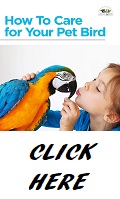

|
Caring for Pet Birds How to Take Care of a Pet Bird |
The First Month of Caring For a Pet Bird Moving to a new home can be stressful for a bird, especially if the bird is a handfed baby. Luckily, if you spend some time setting everything up properly, it isn't too hard to help your bird make the adjustment to a new home. Moving to a new home can be stressful for a bird, especially if the bird is a handfed baby. Luckily, if you spend some time setting everything up properly, it isn't too hard to help your bird make the adjustment to a new home.
The first thing you should do for your new bird is to place his cage in an area that does not have too much traffic and confusion. However, although you don't want him to feel like he is in the middle of everything, you also don't want to put him in an unused room where he will be neglected. Pick a spot where he can interact with you, but won't be constantly startled by loud noises and sudden movements. If you already have another bird, you should quarantine the new arrival for 30 days. This way, if your new bird has an infectious disease, your original bird has a better chance of not catching the disease. To quarantine your bird, you should place him on another floor of the house and keep his food and water dishes separate from your original bird's dishes. If you have central air, you may not be able to truly quarantine your bird, since air ducts carry the air from one room to the next. However, quarantining the new bird is still better than immediately putting them side by side. Next, make sure your bird is healthy. Take him to your avian veterinarian for a well bird visit. Your vet can check to be sure your new pet doesn't have contagious diseases, worms or bacterial infections. This is especially important if you have a newly weaned handfed baby bird because if the bird wasn't handfed properly, he could have a bacterial infection. You should also be sure that your bird is eating well. If he doesn't seem to be eating during the first 24 hours, try offering him spray millet, which is basically dessert for birds. Whole grain cereal also can coax a frightened bird to eat. If you have a newly weaned baby bird that is not eating and he is making a squalling noise, he may have regressed and needs to be handfed a bit longer. Ask your breeder for assistance. If you cannot reach your breeder, you can usually buy some hand feeding formula in pet stores. Simply mix up a very small quantity of hand feeding formula until it has the consistency of pudding and offer it to your bird on a plastic spoon. He should eat it right off the spoon. Finally, don't be afraid to play with your bird or interact in some other way, but don't overdo it. You shouldn't work with your pet bird for more than 10 minutes at a time. If he flies away several times and you have to chase him and catch him, you should put him away until he calms down, since chasing and catching birds is very stressful for them. If he isn't flying away, you should still watch your bird closely for signs of stress as you work with him. |
The First Month of Caring For a Pet Bird - Copyright 2021 by Donovan Baldwin
Page Updated 4:50 PM Thursday, September 16, 2021